Posts: 168
Threads: 2
Joined: Dec 2012
Reputation:
27
(11-07-2016, 09:45 AM)Artloader Wrote: With this figure study from reference, I'm trying to go through the same process as for when I am inventing a figure from imagination. Namely: gesture - skeleton - musculature - values.
My thinking is that if my process for studying from reference is the same as for my invention process, it will make it easier for me to invent fully rendered poses from my imagination.
I totally agree here, everyone should have that kind of thinking. You get so much more from your studies when doing that. Also, you did a really great job on this last study. Keep 'em coming!
Posts: 1,424
Threads: 12
Joined: Dec 2015
Reputation:
139
@Walent: Hey thanks for stopping by and confirming that I'm bumbling along the right path dude :). I appreciate the kind encouragement on the study as well - thanks!
I pushed the rendering a bit more tonight - I really love putting in the veins popping - they used to scare me but after 3 or 4 studies with them I love doing them :). Sometimes small improvements can give a great sense of satisfaction :).
I also couldn't work out what muscles I was seeing on the surface so I again went back to Proko and now I reckon it was the erector spinae that were confusing the heck out of me!
Here's the original reference photo:

Here's my rendering:
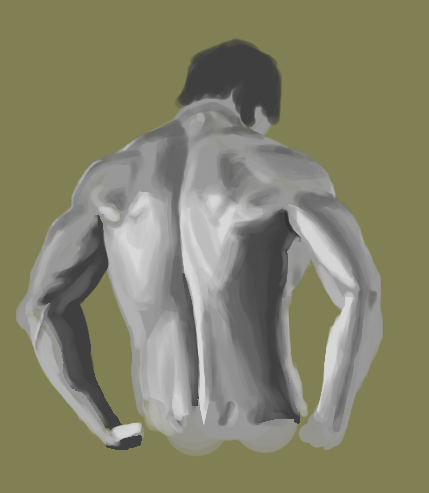
Here's some notes for me to remember:
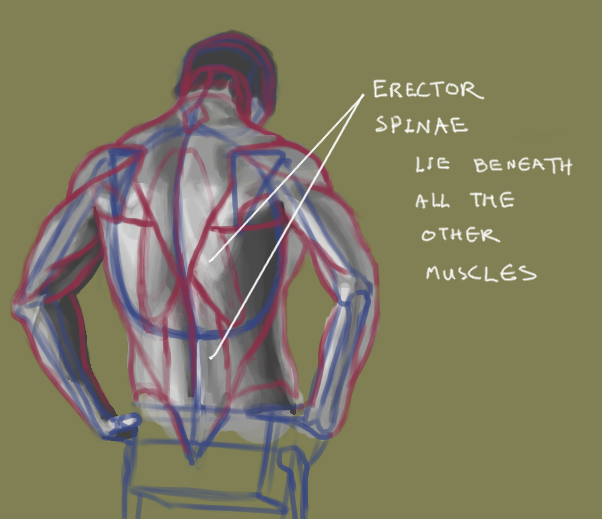
Next I'm gonna have a go at inventing a similar pose and pushing it through to a rendered state.
“Today, give a stranger one of your smiles. It might be the only sunshine he sees all day.” -- H. Jackson Brown Jr.
CD Sketchbook
Posts: 168
Threads: 2
Joined: Dec 2012
Reputation:
27
mnope, the top muscle you labeled is not the erector spinae, that's actually where the fibers of the lats end and the fascia begins, so that's why you see the plane change. At least that's what I manage to see through that watermark. I suggest trying to find reference that shows muscles a bit better, flexed poses and better lighting. Otherwise it won't help, because you'll have to invent the muscles.
Also, now that I see the reference, I can see you pushed the scapulas too much towards the lateral side. In this pose, the opposite happens, the arms go back so the scapulas go closer to the spine and the rhomboids and trapezius bulge.
I know back muscles are freaking hard, I consider them second hardest, after the forearm extensors. So look out for the scapula movements, it's pretty important.
Here's how the erectors create surface (on the right image, the clear highlight on the right side of the spine)

On the left image, you can clearly see the medial end of the latissimus fibers. The erectors create just a slight bulge close to the spine (that's their function, help hold the spine)
Try studying these.
Oh, I also noticed you ignored the serratus, you should look out for that one too, because it creates some surface as well and it got me pretty confused at first. You can basically see it in the right image, under the right scapula and above the fiber ending of the lats, going down from the medial border of the scapula. So there are also a lot of rhythms there, those will help a lot with positioning.
Anyway, hope this helps and hope it's not too much info.
Posts: 1,424
Threads: 12
Joined: Dec 2015
Reputation:
139
@Walent: Wow - really appreciate you taking the time mate - thanks a bunch :).
Quote:mnope, the top muscle you labeled is not the erector spinae, that's actually where the fibers of the lats end and the fascia begins, so that's why you see the plane change. At least that's what I manage to see through that watermark. I suggest trying to find reference that shows muscles a bit better, flexed poses and better lighting. Otherwise it won't help, because you'll have to invent the muscles.
Yes I see now that I had an incorrect understanding of the erector spinae. Also - great tip on using more ripped references - I guess I was trying to get used to rendering a thin layer of fat over the muscles - but in order to do that I need to understand the muscles first!
Quote:Also, now that I see the reference, I can see you pushed the scapulas too much towards the lateral side. In this pose, the opposite happens, the arms go back so the scapulas go closer to the spine and the rhomboids and trapezius bulge.
I know back muscles are freaking hard, I consider them second hardest, after the forearm extensors. So look out for the scapula movements, it's pretty important.
Hmmm - I used the teres major to locate the bottom of the scapulae here but I've just done a bit more research and the scapulae actually extend slightly more medially than the medial tip of the teres major so considering this along with the position of the arms, I see now that the scapulae should be more medial than I have them - thanks :).
Quote:On the left image, you can clearly see the medial end of the latissimus fibers. The erectors create just a slight bulge close to the spine (that's their function, help hold the spine)
Try studying these.
Many thanks dude - great refs. I will give these a study :).
Quote:Oh, I also noticed you ignored the serratus, you should look out for that one too, because it creates some surface as well and it got me pretty confused at first. You can basically see it in the right image, under the right scapula and above the fiber ending of the lats, going down from the medial border of the scapula. So there are also a lot of rhythms there, those will help a lot with positioning.
Hey you're so right! I forget that the serratus wraps around to the back - I'll shall give this a study.
Quote:Anyway, hope this helps and hope it's not too much info.
Oh man it really helped - thanks a shed load Walent :).
“Today, give a stranger one of your smiles. It might be the only sunshine he sees all day.” -- H. Jackson Brown Jr.
CD Sketchbook
Posts: 1,424
Threads: 12
Joined: Dec 2015
Reputation:
139
Started studying from the refs. Walent gave me. I thought it best to start off with a skeleton trace and build on from there.
Also trying to claw back some sleep time so I'm gonna leave it here for tonight - not much done (just 45mins) but better than nothing :).

“Today, give a stranger one of your smiles. It might be the only sunshine he sees all day.” -- H. Jackson Brown Jr.
CD Sketchbook
Posts: 168
Threads: 2
Joined: Dec 2012
Reputation:
27
Try taking your time, seems like you're rushing things. Take a closer look at the humerus bone, see how the medial epicondyle is very pointy, while the lateral one is round.
The left scapula isn't outlined right, I don't think that position is even possible, no matter how you move your arm. I'll give you a tip: always look for the teres major, it helps you determine the lower corner of the scapula because that's the origin of the muscle.
Posts: 1,424
Threads: 12
Joined: Dec 2015
Reputation:
139
@Walent: I really appreciate you persevering with me dude - thanks :).
Quote:Try taking your time, seems like you're rushing things. Take a closer look at the humerus bone, see how the medial epicondyle is very pointy, while the lateral one is round.
Yep - you're right I was rushing and didn't really study the epicondyles closely - good catch - I've had a go at fixing that below.
Quote:The left scapula isn't outlined right, I don't think that position is even possible, no matter how you move your arm. I'll give you a tip: always look for the teres major, it helps you determine the lower corner of the scapula because that's the origin of the muscle.
OK I've labelled what I think is the Teres Major on the left scapula and then had another go at it - hopefully it's a bit nearer the mark this time?
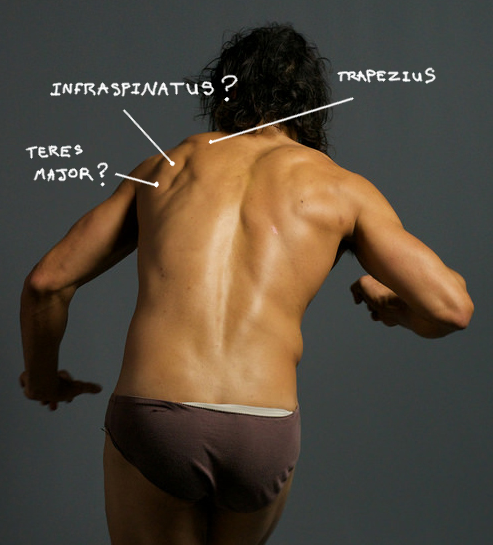
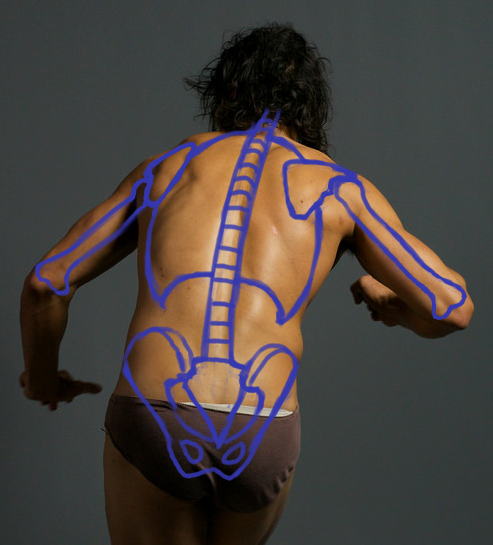
“Today, give a stranger one of your smiles. It might be the only sunshine he sees all day.” -- H. Jackson Brown Jr.
CD Sketchbook
Posts: 168
Threads: 2
Joined: Dec 2012
Reputation:
27
Posts: 1,424
Threads: 12
Joined: Dec 2015
Reputation:
139
@Walent: Cool - thanks :).
I had a go at some of the more deep lying muscles - serratus anterior and erector spinae.
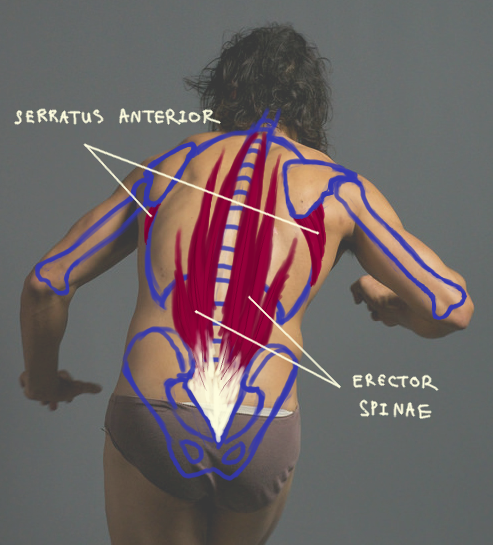
“Today, give a stranger one of your smiles. It might be the only sunshine he sees all day.” -- H. Jackson Brown Jr.
CD Sketchbook
Posts: 1,424
Threads: 12
Joined: Dec 2015
Reputation:
139
Stuck in some rhomboids on this fella. They look a bit strange to me but I just followed the location of his scapulae. I guess this guy is doing funny things with his scapulae:
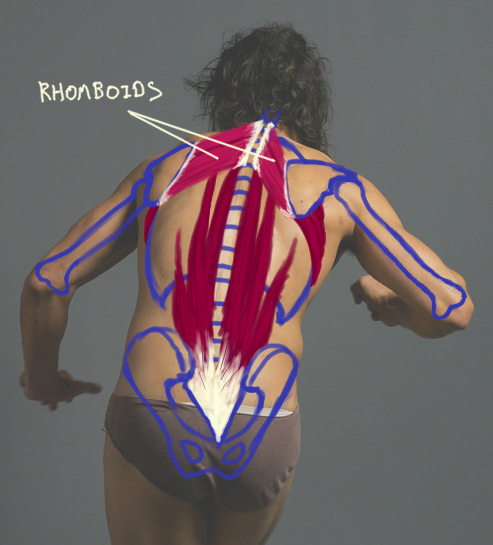
“Today, give a stranger one of your smiles. It might be the only sunshine he sees all day.” -- H. Jackson Brown Jr.
CD Sketchbook
Posts: 1,424
Threads: 12
Joined: Dec 2015
Reputation:
139
Thought I'd change study techniques a bit and have a go at an écorché painting. These are slow going because I keep having to stop and research each muscle. Had fun doing this though :).
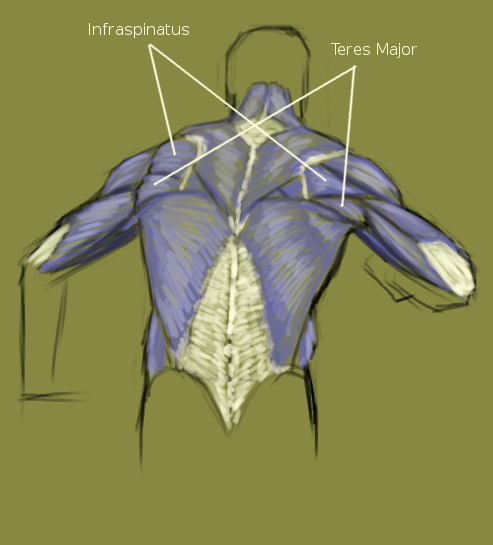
“Today, give a stranger one of your smiles. It might be the only sunshine he sees all day.” -- H. Jackson Brown Jr.
CD Sketchbook
Posts: 1,424
Threads: 12
Joined: Dec 2015
Reputation:
139
Pressing on with finding a process for constructing and rendering an invented figure.
Here's my current process:
1. Skeleton
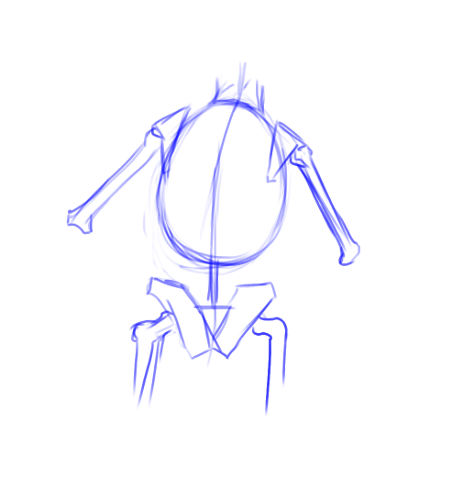
2. Muscles
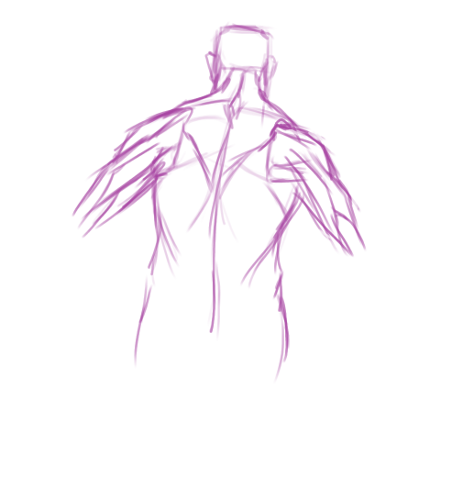
3. Values

“Today, give a stranger one of your smiles. It might be the only sunshine he sees all day.” -- H. Jackson Brown Jr.
CD Sketchbook
Posts: 2,817
Threads: 15
Joined: Jun 2013
Reputation:
109
It's tough but you're doin it!!
Posts: 1,109
Threads: 18
Joined: Apr 2014
Reputation:
68
hey dude, I said I'd post you this stuff a while back but took my sweet time, perhaps it's useful at this point. Basically the idea is that you build up the shapes into a silhouette that gives you something 'complete', quite quickly, to assess as to whether it's what you want, and if the pose is clear, and if proportions look ok, at which point you can dive into the full construction / values etc. as you've been doing above - it's just another way to go about things but is quite fun, and it can give more confidence that the end result is gonna look ok. Excuse the crappy lineworks I did, from that point they can be developed more carefully / fastidiously than I did. Hope it's useful!

My characters are more cartoony here, but this totally works with realistic figures too.
Posts: 1,424
Threads: 12
Joined: Dec 2015
Reputation:
139
Oh man this looks soooo useful - thanks Johnny!
Often in the past I've found I had an idea for a pose in my head but when I dive in with a full on construction - it loses it's energy and fluidity - I think starting out with a more carefree approach like this and then going in with construction will really help. Awesome!
“Today, give a stranger one of your smiles. It might be the only sunshine he sees all day.” -- H. Jackson Brown Jr.
CD Sketchbook
Posts: 1,424
Threads: 12
Joined: Dec 2015
Reputation:
139
I'm trying to set up a routine for myself where I cycle around from studies - an illustration - my comic project and back again.
So now I'm moving onto the illustration part of the cycle - some kettle studies for a book cover illustration.
I learned a couple of things with this:
- After reading about so many different painting techniques, I kind of lost track of the fact that I wanted to achieve a more painterly style in my art. Here I remembered my desire to achieve a painterly style and found that this is better achieved by using a hard brush instead of a soft one.
- Working from large and simple to small and detailed. This approach is so useful in managing complexity. For example, I was scared of attempting the textures on kettle number 4 but by applying the principle of working from large to small I felt more confident.
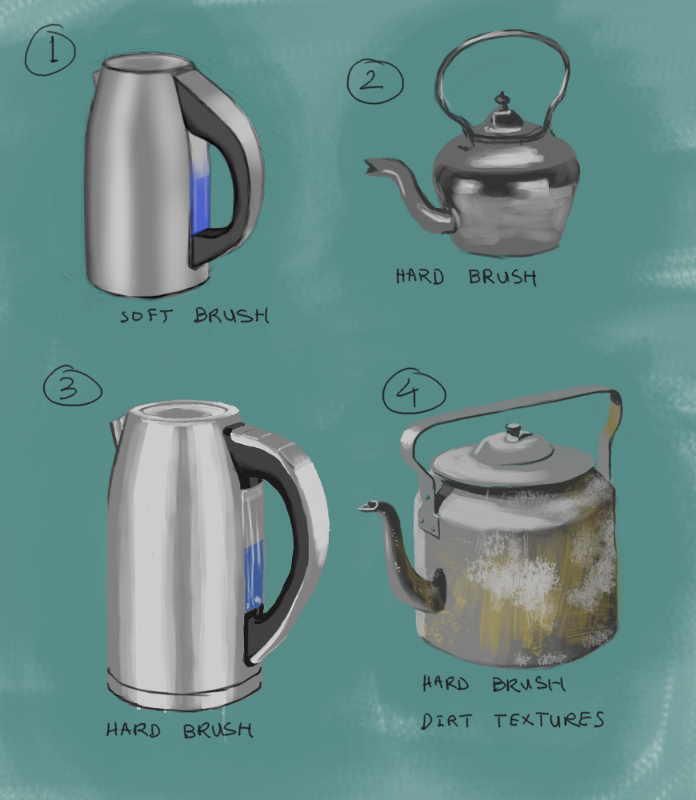
“Today, give a stranger one of your smiles. It might be the only sunshine he sees all day.” -- H. Jackson Brown Jr.
CD Sketchbook
Posts: 1,424
Threads: 12
Joined: Dec 2015
Reputation:
139
(12-02-2016, 03:22 AM)Autoronin Wrote: Hey, its awesome to see all the work you've been putting in on this anatomy stuff! Great to see your progression.
Thanks dude - it's slow going but I'm enjoying the journey at the moment :).
Here's a study of a puppy-dawg for a project I'm doing with an author friend of mine. I'm starting to build up a painting workflow that feels good to me now. Blocking in colours and then refining the blocks, adding details etc.

“Today, give a stranger one of your smiles. It might be the only sunshine he sees all day.” -- H. Jackson Brown Jr.
CD Sketchbook
Posts: 8
Threads: 1
Joined: Dec 2016
Reputation:
1
Hey man, good anatomy work you've got there. Have you by any chance looked at the Vilppu stuff? People say it's one of the best resources on anatomy. Just a heads up, they're closing up shop 12/31.
Posts: 1,424
Threads: 12
Joined: Dec 2015
Reputation:
139
@Brokenspears: Thanks - I've come across the Vilppu stuff before but it was always a bit above my price range. I've been mainly studying from Hampton (who has studied some of Vilppu's stuff) and Proko.
I've been pushing on with digital painting, focusing on the process of first blocking in the big shapes and then working down to the smaller shapes.
Here's a study of a candle lit shack:
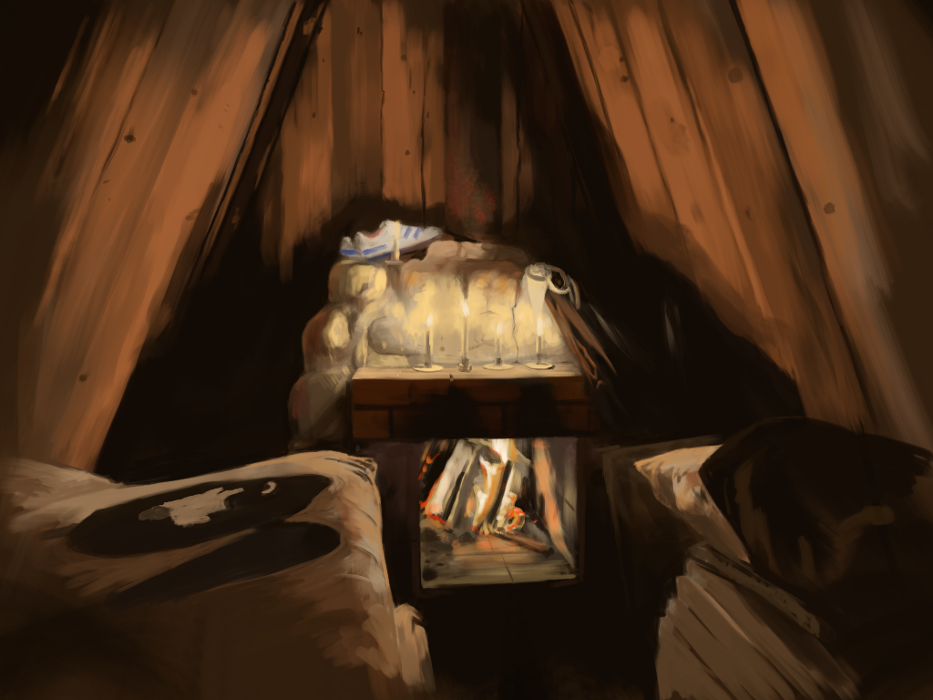
Here's the ref:
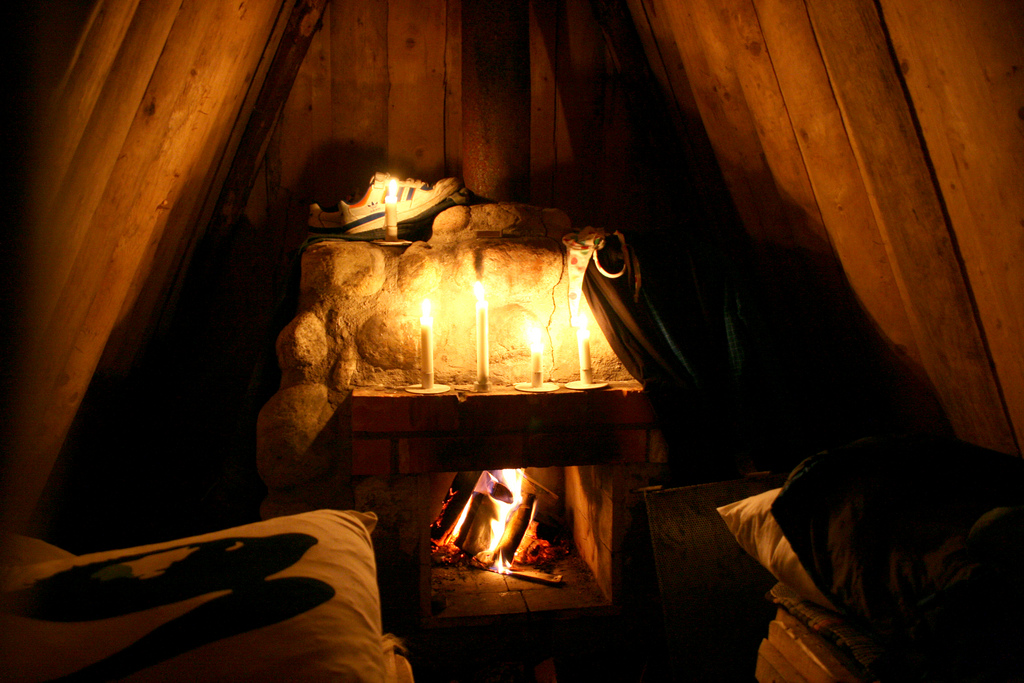
My hues and values are way off. I need to practice guessing these more.
“Today, give a stranger one of your smiles. It might be the only sunshine he sees all day.” -- H. Jackson Brown Jr.
CD Sketchbook
Posts: 1,424
Threads: 12
Joined: Dec 2015
Reputation:
139
After Johnny's tips on silhouettes, I'm trying to include silhouettes in my workflow for painting the human figure.
My current process is this:
1. Gesture.
2. Silhouette with 100% opacity brush.
3. Shadow shapes with 100% opacity bursh.
4. Full light shapes with 100% opacity brush.
5. Blending with pressure opacity brush (added some highlights and reflected light here for fun).

“Today, give a stranger one of your smiles. It might be the only sunshine he sees all day.” -- H. Jackson Brown Jr.
CD Sketchbook
|



























